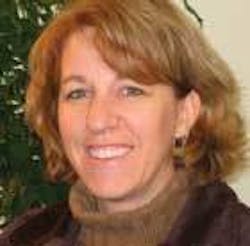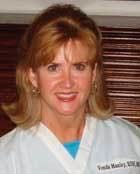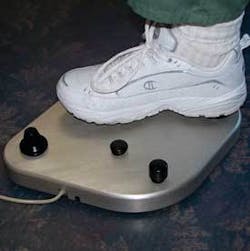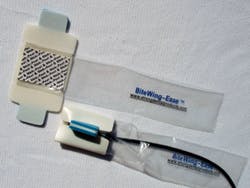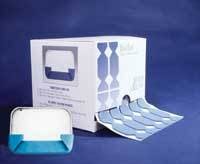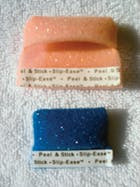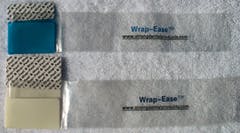bright ideas
Imaginative inventions by hygienists!
by Cathy Hester Seckman, RDH
Specialty dental products make our lives easier. With this doo-hickey or that doo-flinkey, hygienists can get the job done easier, faster, and more efficiently. Do you ever wonder where the doo-hickeys and doo-flinkeys come from?
Two of them, one low-tech and one high-tech, came from the inventive imaginations of dental hygienists who saw needs and filled them.
Vonda Manley of Corona, Calif., president and CEO of Strong Dental Products Inc., invented a series of cushioning aids for X-ray film and sensors. The small, blue Edge-Ease wraps, first marketed in 1985, can be found in hygiene operatories all over the country. Alongside these items can be found BiteWing-Ease, Sensor Slippers, Slip-Ease, and Wrap-Ease products.
Becky Logue of Meridian, Idaho, owner of Beckmer Products Inc., created a more high-tech invention - the Dental RAT. The RAT is a foot-operated computer mouse that plugs into a USB port and provides hands-free operation for entering periodontal probe readings into an operatory computer.
This is how each product evolved from a hygienist’s idea to a marketable product.
Becky Logue
Becky Logue wanted to be a hygienist since she was 13, though she didn’t really understand what that meant.
“I was right out of high school, and didn’t even know what an amalgam was when I started studying ‘Principles and Properties of Amalgams,’” she said.
She earned a bachelor’s degree in dental hygiene from Idaho State University in 1987.
“I’d do it all over again. Hygiene is the best profession if you enjoy helping people.”
Logue has worked in general and periodontal practices since then, and still does clinical hygiene one day a week.
“I’ve been in all kinds of offices, from those with no technology to those with the highest technology. At first, high technology intimidated me. It seemed time-consuming, but as you use it, it becomes much easier.”
Annoyance with technology is what encouraged Logue to invent the Dental RAT.
“I was frustrated with what was available,” she remembers. “I wanted something to help me perio chart by myself, accurately, in the computer. One day I couldn’t get anyone to help, and I was telling my patient about my idea for hands-free computerized charting. He was an engineer who knew another engineer and a patent attorney, and he told me he thought they could help.”
Logue had already looked into foot-operated data entry, and when she couldn’t find anything like what she had in mind, she called the patent attorney her patient had recommended.
“At first he laughed and said, ‘I’m sure someone’s thought of that.’ But then he did a search and nothing came up, so we were off and running. I hired the engineer and told him what I wanted.”
It was a long process to get in sync with the engineer. But they took it one step at a time, and eventually came up with a prototype. Then it started to get expensive.
“At first I came home and asked our family (husband, Mert, and a blended household of four children) if I could have our pool money savings for a RAT. They were very supportive, but now it’s been more like buying a pool and a house!”
Though she was excited about developing the product, Logue was also frightened.
“That was a lot of money to spend, and it kind of scared me.”
When the pool money was spent, Logue still needed start-up money to launch the RAT, so she looked for grants.
“I was a woman who had developed a new product, and I needed financial help to get it to market. The state Department of Commerce and Labor brought me to Boise State University’s Technology and Entrepreneurial Center. They helped me learn the whole business side of business that I didn’t learn in hygiene school. They taught me things like building a business plan, doing a stock offering, hiring, setting up cash flow and revenue plans, and handling legal issues. They were incredible, and I still consult with them. I would hope most states have something like this in their small-business development centers.”
The Dental RAT went on the market a few years ago in beta-testing mode, and was officially launched in 2006. Response has been excellent.
“We’ve been getting a lot of RATs out all over the United States. Hygiene schools are starting to incorporate them into their curriculum. Students think it’s fun, and I believe if students are proficient on it they’ll be more employable.”
She’s had to broaden her horizons the past year in order to market the RAT to the hygiene profession.
“I’ve always been insecure about public speaking, but I’ve had to do a lot of it. Working at booths at dental shows is rough, too, but I’ve met so many incredible people that it is worth stepping out. I’ve learned it’s good to get out of my comfort zone. It’s all getting easier, and I keep telling myself that I’m excited, not scared.
“I’ve had tons of support from my husband, friends, and family, and many prayers. My husband is a huge part of this company, and he has been very supportive. I don’t think a lot of people could jump out on a limb with me like he has.
“All this helps in the confidence area. I haven’t had time to get discouraged, because something different pops up every day that is a new challenge.”
Logue calls herself a risk-taker.
“It’s stressful putting so much money into something, but I believe you have to take risks to get ahead.”
She worries about career-related injury, and her get-ahead idea is to retire early from clinical hygiene, “preferably on a beach somewhere. I believe from the feedback that Dental RAT will continue to be a successful business, and hopefully that beach will be full of lots of other happy hygienists.”
A second Dental RAT model is in the works.
“A lot of dentists have asked for a model without the numbers for running their operatories and manipulating X-rays and intraoral photos. It’s all about avoiding cross-contamination. Patients watch where our hands go, and they love sterile technology. Plus, a lot of dentists are like hygienists. They don’t want to constantly rely on someone else to help them.”
Logue has also had some interest from the medical profession. Surgeons have asked her about possible applications for the RAT in surgery.
“There are a lot of avenues my patent could branch into. Besides surgery, there could be applications for the disabled, in food service, and in manufacturing. But I want to focus just on dental products for now, and do that well.”
Vonda Manley
When Vonda Manley invented her first dental product, she had her own comfort in mind.
“When I was a patient, I always had lacerations sublingually or on my palate after X-rays. My mouth was sore for two or three days. I hated doing that to my patients. So I invented the Edge-Ease.”
That was in 1985. Manley had been practicing full time in general practices in Spokane, Wash., after she graduated in 1979 from Eastern Washington University with a bachelor’s degree in dental hygiene, and from Whitworth College in 1982 with a master’s degree in health science.
One day she sat down with paper, scissors, and double-stick tape to build a stick-on cushion for X-ray film. She hired a patent attorney, and started looking for a manufacturer.
“One day I had an unexpected morning off work because a family had cancelled due to the flu. I got out the phone book and looked under ‘foam’ and ‘rubber.’ I picked out a company in Spokane, and called them to ask questions. I didn’t want to reveal too much about the Edge-Ease, because I was still in the patenting process. By extreme coincidence, the guy I was talking to was a patient of mine. I then felt safe talking to him, and he invited me to look at materials. I went that same morning.”
When it was time to order her first batch of Edge-Ease from the manufacturer, she was told the minimum order would be 25,000.
“I thought, ‘Oh, my goodness gracious, I can never go through with this!’ At that point, I was thinking I would only use the cushions with my own patients. It didn’t click with me right away that this could take off as a business. Just the steel rule die used to cut the shapes was $150, and that was a lot of money to spend for my own convenience 20 years ago. But I wanted them, and eventually I said, ‘Go ahead. Make them.’”
Manley then started working on a marketing plan. Using a Kodak Instamatic camera, she took pictures of her prototypes and sent them to Dental Products Report magazine with the explanation, “I’m a hygienist, I’ve invented this product, and I don’t have a marketing budget. Can you help me?”
Dental Products Report put Manley’s picture on its Sept. 1986 cover, without telling her in advance.
“It was a total surprise. One day in the office, my boss said, ‘Vonda, come look at this. They put your product on the cover.’ He always teased me, so I didn’t believe him at first.”
But it was real, and because of that cover photo, Manley had orders for 50,000 Edge-Ease before her first 25,000 were even delivered. “That’s when I knew the product was marketable. I had professional photographs taken, a brochure made - this was all in precomputer days - and started sending out samples to people who had used the reader service card in Dental Products Report. I gave Edge-Ease samples to all the hygienists I knew, sent samples to dental offices all over the area, and everyone asked for more. Before I knew it, dental supply companies were contacting me.”
A year later, business was booming for Strong Dental Products, Inc. (Strong is Manley’s maiden name). Manley was offered a position in the San Francisco Bay area, where her family lives, as a Star handpiece representative. So she moved back home, hired a nephew to run the business, and went to work as a product rep.
“I worked for Star for three years, then was transferred to southern California, but I left the business with my nephew in the Bay area. A year later he quit to go to college, and I wondered what to do.”
She decided that Strong Dental Products was important to her, so she resigned from Star, moved the business to Corona, Calif., and has been a full-time entrepreneur ever since.
She licenses a manufacturer to make the products and employs a shipping clerk for packing and mailing, but otherwise, Manley handles every aspect of the business from her home: invoicing, billing, daily operations, sales and marketing, and sales meeting and trade show travel.
The company recently expanded its line to include four products for use with digital film sensors. BiteWing-Ease, Sensor Slippers, Slip-Ease, and Wrap-Ease were introduced in 2006, and have doubled Manley’s business volume.
“They weren’t even in catalogs last year,” Manley points out. “That just shows us there’s a huge need for comfort cushions in the digital world. Everyone’s loving my product.”
What’s so amazing about Manley’s business success is that anyone could do it.
“All I had was a simple solution to a problem, and it’s been a hit. I really encourage other hygienists out there working every day to use their potential. How many times have you said, ‘I wish somebody would make something that would ...’
“That’s what I said: ‘I wish somebody would make X-rays more comfortable.’ If you catch yourself saying that, change it to, ‘Why am I waiting for someone to do this? I’ll just do it myself.’ If we all listen to our creative ideas, there’d be so many more marketable products.” RDH
Dental RAT
A Dental RAT is a diamond-shaped footpad with five buttons and a joystick. The joystick, at the top, is operated by your toe to move the cursor in any direction. Four buttons across the center of the pad are used to record periodontal probe readings. If pressed once, each button records 1, 2, 3, or 4. If pressed and held, they record 5, 6, 7, or 8. The right-most button is used like a right-click button on a hand mouse. The button at the bottom of the RAT is the left-click button, and is operated with your heel.
The RAT simply plugs into a USB port and works with any software, not just dental software. Logue’s children have used one with their video games.
•For more information on the Dental RAT, visit www.dentalrat.com or call Beckmer Products Inc. at (877) 278-0061.
Manley’s other business
Vonda Manley, inventor and marketer of X-ray film and sensor comfort cushions, didn’t stop with the dental field. At one time she owned a line of beauty-care products, and she still manufactures and markets a self-tanning lotion she invented.
“In 1989, when I still lived in Washington, I had a basal cell carcinoma on my nose. Then I moved to California, and I had to be really careful about being out in the sun. I used sunless tanning lotion so I wouldn’t look so white all the time, but I couldn’t find one that smelled good. I went to see a chemist, and before I knew it, I ended up with an entire beauty-care line. I didn’t really intend for it to happen, but it became a big business.”
Besides the sunless tanning lotion, called “Beach,” Manley sold shower gels, moisturizers, body lotion, bubble bath, sunscreen, and a whole children’s line.
“I had pallets and pallets of beauty products stacked all around my dental products. I didn’t have time for both businesses, so I had to make a choice. I decided that my heart was in dentistry, so I sold off all the beauty products except for Beach sunless tanning lotion, which I still sell in boutiques around my area.” It’s also sold on the Internet at www.strongproducts.com. In 2003, Beach won a sunless tanning contest for Best Color.
Strong Dental Products, Inc.
Vonda Manley’s company, Strong Dental Products, Inc., has been selling X-ray film and sensor adjuncts since 1985. There are five products, all fragrance- and latex-free:
BiteWing-Ease - This product is an all-in-one barrier sleeve, sensor cushion, and positioning aid. It creates its own bitewing tab, which is just the right thickness to prevent the patient from biting on the sensor cord.
Edge-Ease - Chosen for the 2003 “Outstanding Products Buying Guide,” the Edge-Ease protects soft tissue from film or holder abrasion, and allows easier film or sensor placement. The cushions adhere for patient safety.
Sensor Slippers - These are an all-in-one barrier sleeve, cushion, and positioning device for X-ray sensors.
Slip-Ease - The Slip-Ease cushions wireless sensors, film, and phosphor plates, and has a restickable safety strip so it may be used for an entire full-mouth series.
Wrap-Ease - Wrap-Ease is an adjustable all-in-one barrier sleeve, sensor cushion, and positioning aid that works with Rinn holders and stick-on tabs. The seamless sleeve will not abrade tissue or split open.
• For more information about Manley’s products, visit www.strongdentalproducts.com or call (800) 648-9729.
Cathy Hester Seckman, RDH, is a frequent contributor based in Calcutta, Ohio. Besides working in a pediatric dental practice, Seckman is a prolific freelance writer, a book indexer, and a speaker on dental and writing/indexing topics. She can be reached at [email protected].
